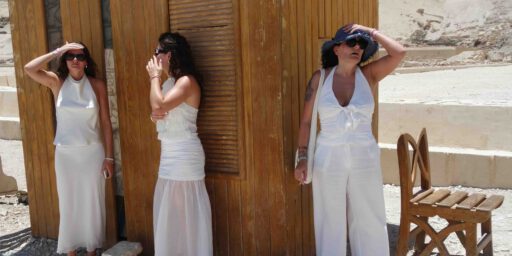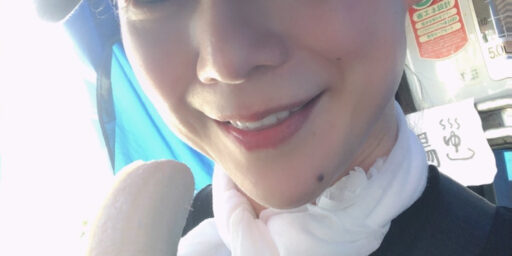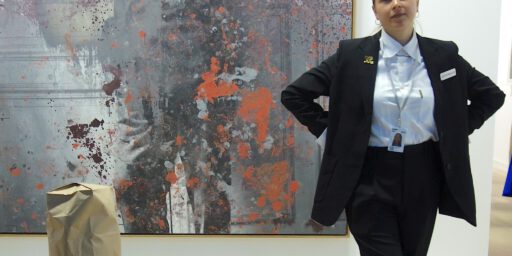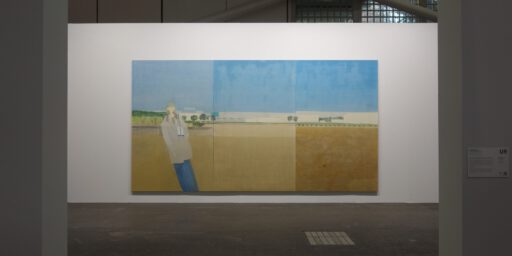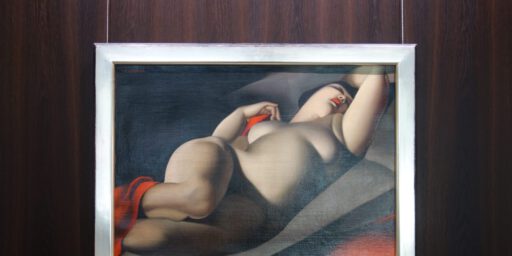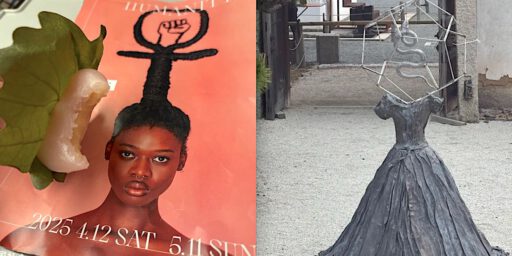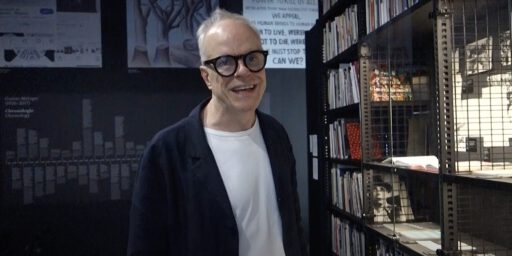平和祈念展示資料館、小柳次一、宇多村英恵、大岩オスカール、明治天皇、昭和天皇、大嘗祭 Memorial Museum for Soldiers, Detainees in Siberia and Postwar Repatriates, KOYANAGI Tsuguichi, UTAMURA Hanae, OIWA Oscar, Emperor Meiji, Emperor Showa, Religious Imperial Enthronement Rites (DAIJO-SAI)

Just by chance I took notice of a minor exhibition, introduced in the Asahi Newspaper: “Two ways to capture the war by photographer KOYANAGI Tsuguichi 小柳次一”. That got me interested in visiting the “Memorial Museum for Soldiers, Detainees in Siberia and Postwar Repatriates”. The Japanese name sounds purposely ambiguous, could be boldly called “Memorial Peace Museum”, located on the 33rd floor of the Sumitomo Building in Shinjuku, Tokyo.
Days ago, the exhibition “What is Europe? Views from Asia” at the British Museum, sponsored by the Asahi Newspaper, had been advertised via “artdaily”. It caught my eye because the pictorial motive for promotion featured the Emperor Meiji. In this context, I should mention, that in Japan we nowadays read a lot of thought-provoking news related to the Emperor’s abdication, Imperial Household Agency, Emperor Showa’s questionable war responsibility, destroyed war documents, and possible amendments regarding the “peace-constitution”. I hereby take the opportunity to post some relevant links, pics and news.
In case of interest, I recently posted some articles about the relationship between Japanese artists and problematic political topics:
天皇皇后両陛下 初の肖像画
Portrait Painting of Their Majesties the Emperor and Empress of Japan
https://art-culture.world/articles/portrait-painting-of-their-majesties-the-emperor-and-empress-of-japan/
up-date:
日本文化の象徴、2019年1月1日
The Symbol of Japanese Culture, 1st January 2019
https://art-culture.world/articles/the-symbol-of-japanese-culture-1st-january-2019/
天皇制の為:下らない横山大観戦争画 ー 内閣総理大臣顕彰受賞者村上裕二
For The Sake Of The Emperor: Trashy Taikan YOKOYAMA – Yuji MURAKAMI (Prime Minister’s Award Honoree)
https://art-culture.world/articles/for-the-sake-of-the-emperor-trashy-taikan-yokoyama-yuji-murakami-prime-ministers-award-honoree/
日独伊三国同盟ファシズム:横山大観とベニート・ムッソリーニ
Fascism Axis Japan-Germany-Italy: Nihonga Painter YOKOYAMA Taikan and Benito Mussolini
https://art-culture.world/articles/fascism-axis-japan-germany-italy-nihonga-painter-taikan-yokoyama-and-benito-mussolini/
藤田嗣治・Léonard Foujitaの作品との出会い(1)
Encountering the works by Léonard Tsuguharu Foujita (1)
https://art-culture.world/articles/encountering-the-works-by-léonard-tsuguharu-foujita-1/
ART+CULTURE readers know, that from time to time I like to share pics from exhibitions I visited. Actually I find two shows in the Ginza area worth to mention:
Holiday at War 戦争と休日
’12th Shiseido Art Egg’ Hanae Utamura Exhibition @ Shiseido Gallery
「第12回 shiseido art egg 宇多村英恵」展 @ 資生堂ギャラリー
2018.8.3 ~ 8.26
https://www.shiseidogroup.jp/gallery/exhibition/
and
Oscar Oiwa A Light-filled Ginza @ Tokyo Gallery+BTAP | Tokyo
大岩オスカール「光の満ちる銀座」 @ 東京画廊+BTAP
2018.7.21 – 9.22
http://www.tokyo-gallery.com/en/exhibitions/intokyo/post-420.html

新宿の住友ビル Sumitomo Building in Shinjuku, Tokyo
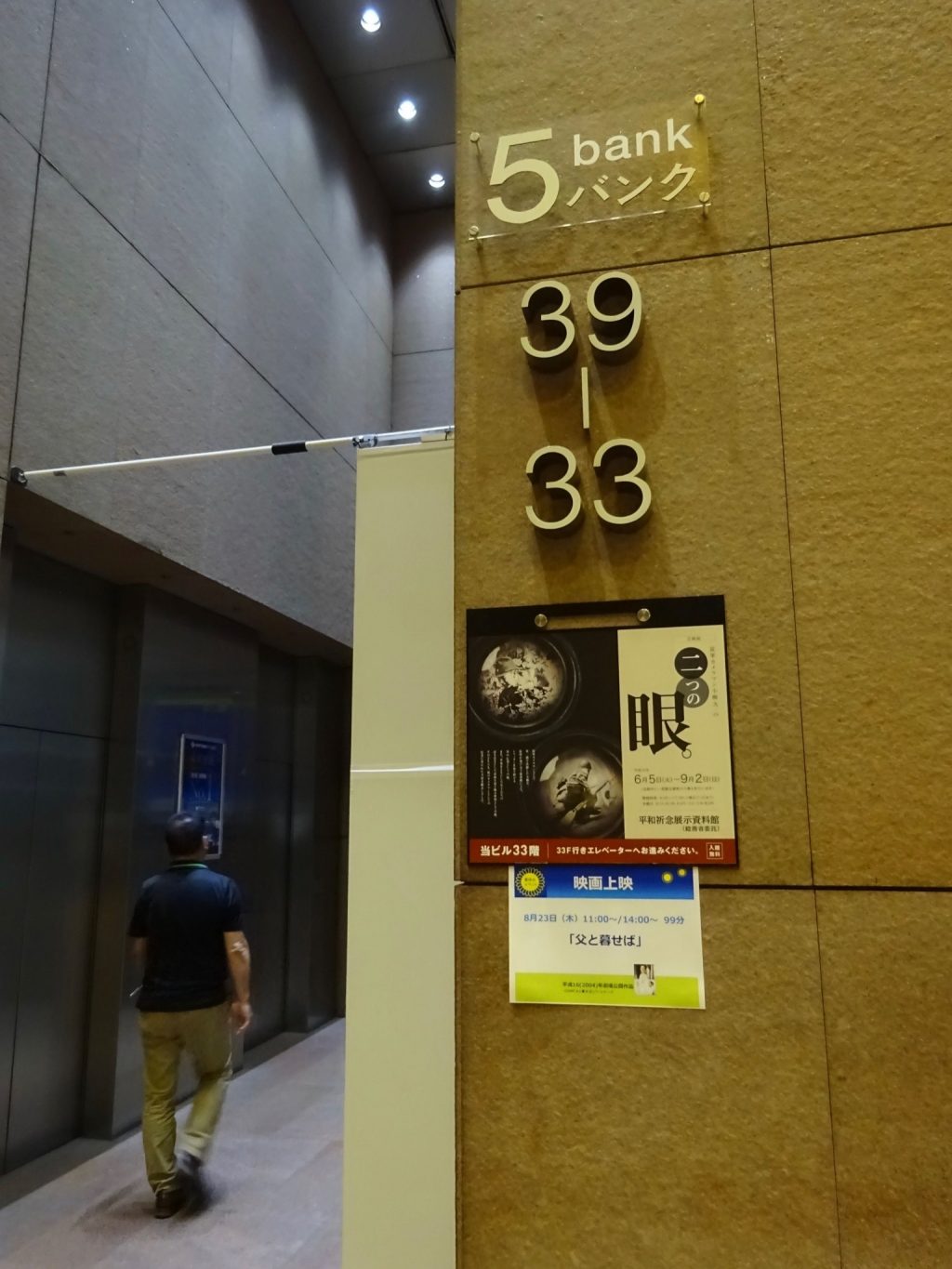
The “Memorial Museum for Soldiers, Detainees in Siberia and Postwar Repatriates” is located on the 33rd floor of the Sumitomo Building, Shinjuku

平和祈念展示資料館は、さきの大戦における、兵士、戦後強制抑留者および海外からの引揚者の労苦(以下、「関係者の労苦」)について、国民のより一層の理解を深めてもらうため、関係者の労苦を物語る様々な実物資料、グラフィック、映像、ジオラマなどを戦争体験のない世代にもわかりやすく展示しています。
また、資料を有効活用し、効果的な方法で幅広く労苦を語り継ぐため、全国で展示会などの館外活動を展開しています。
“Memorial Museum for Soldiers, Detainees in Siberia and Postwar Repatriates”
Open every day, except Monday, 09:30 to 17:30, free admission
http://www.heiwakinen.jp/english/index.html
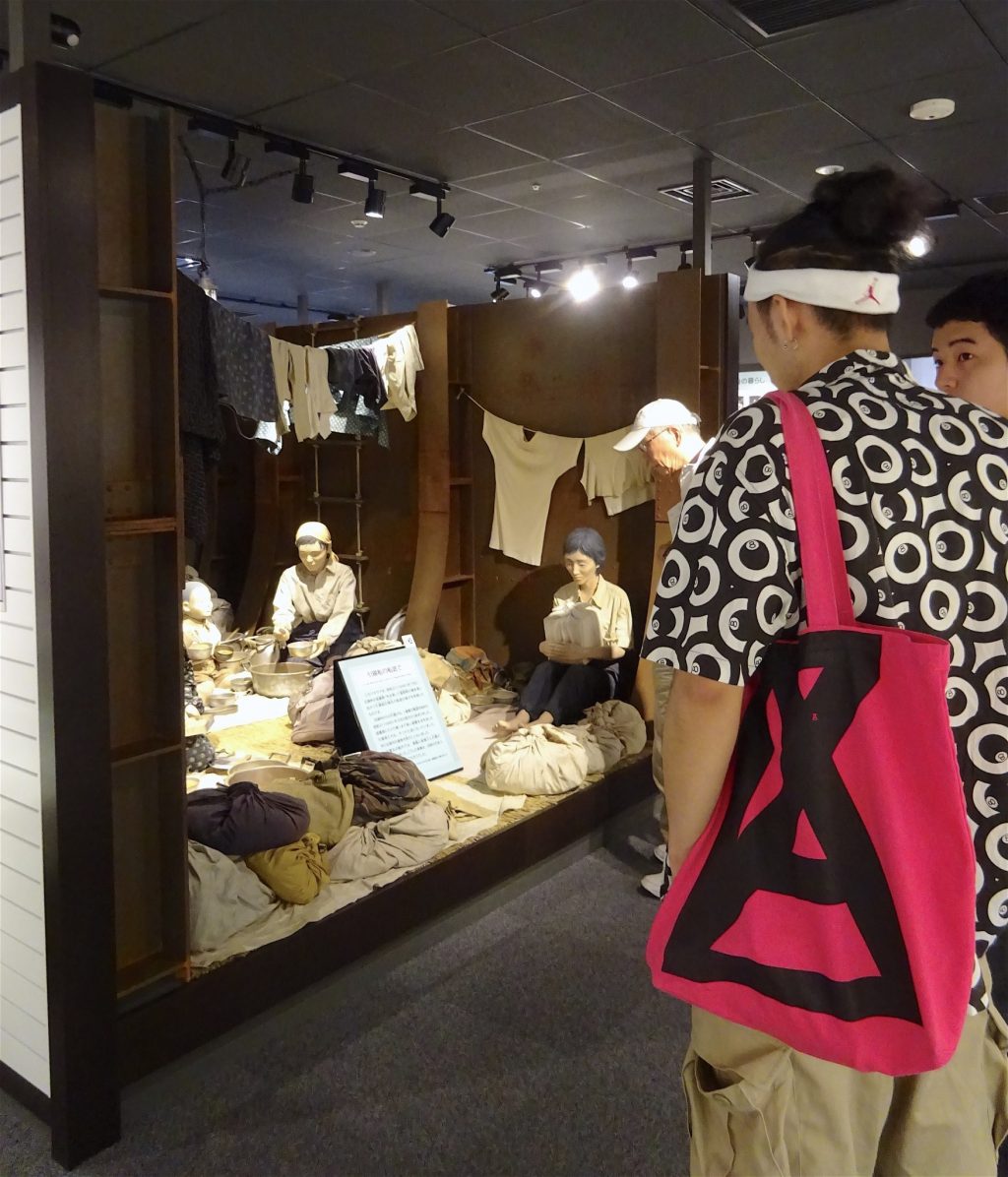
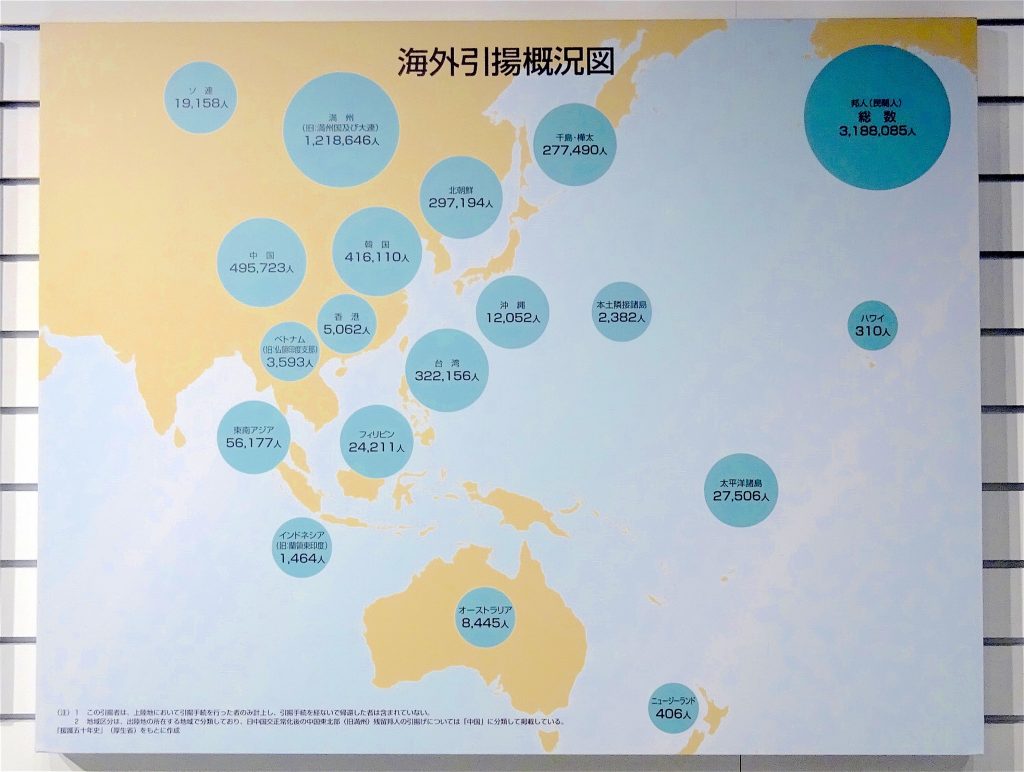
公文書クライシス
満蒙開拓団、戦後調査資料 廃棄・不明、14道府県
毎日新聞 2018年8月26日
1932~45年、旧満州(現中国東北部)に国策で推計約27万人が送り込まれた「満蒙(まんもう)開拓団」について、戦後に都道府県が実施した全国実態調査の資料が13道府県で確認できず、1県は廃棄したことが毎日新聞の全国アンケートで判明した。戦後間もなく団の幹部らから直接聞き取りした、他にはない貴重な1次資料だが、資料の残る33都府県も保存期間はまちまちで、今後廃棄される可能性もある。
資料は外務省が50年に都道府県に調査を指示した「満蒙開拓団実態調査表」。15~19歳(数え年)の8…
http://mainichi.jp/articles/20180826/ddm/001/010/165000c
Records of Japanese settlers in Manchuria, Inner Mongolia not found or discarded in 14 prefectures
August 26, 2018 (Mainichi Japan)
quote:
Japan sent some 270,000 farming settlers to its puppet state of Manchukuo in northeastern China from 1932 through 1945. The settlement was designed to ease the hardships of local farming villages in Japan following the depression of 1929, as well as decrease the pressure of population growth in Japan, increase food production and guard against a potential Soviet invasion on the frontier of Imperial Japan’s influential area.
…
“Leaving the records discarded means an obliteration of history. They should not be left to prefectural departments. The documents should be kept permanently at public archives.”
http://mainichi.jp/english/articles/20180826/p2a/00m/0na/006000c
Anke Scherer: Japanese Emigration to Manchuria
quote:
One of the main arguments of promoters of mass migration to Manchuria from the impoverished Japanese countryside in the 1930s and early 1940s was the inevitability of such a move. It is noteworthy that until a few years before the founding of Manshūkoku the resettlement of Japanese peasants on the continent was regarded as a hopeless endeavour, because the living standard of Chinese peasants and prices for agricultural products in the region were so low that Japanese peasants were not seen fit to compete in that market. As late as 1928, Yamamoto Jōtarō, president of the South Manchurian Railway Company, advised against bringing larger numbers of Japanese farmers to Manchuria. Up to 1931, the most influential magazine for the rural region, Ie no hikari, recommended emigration to Brazil. Even Nasu Hiroshi, who later became the most active proponent for Japanese emigration to Manchuria in academic circles, doubted in 1927 that mass migration to Manchuria could remedy the problem of the presumed overpopulation in Japan (Wilson 1995: 256, 259).
With the expansion of Japanese dominance in Manchuria, the mood changed. Different interest groups came together at the beginning of the 1930s and started advocating the creation of Japanese settlement in Manshūkoku. The Kantō Army, the military power in the region, saw these settlements as a way to spread Japanese influence over wider areas of the vast Manchurian countryside, as a reservoir for future soldiers, and as a source of food for the army. The influence of these local military advocates of Japanese immigration into the region can be seen especially in the test phase from 1932 to 1936, when the majority of settlers were reservists sent to Manchuria with the proverbial hoe in one hand and a rifle in the other. Emigration was often seen as a service for the empire, just like service in the army. In the beginning of the migration movement, settlers were therefore immune from military conscription. However, this promise was null and void in the last phase of World War II when nearly all male settlers between 18 and 45 years of age were drafted into the army (Young 1998a: 354, 408).
http://www-brs.ub.ruhr-uni-bochum.de/netahtml/HSS/Diss/SchererAnke/Zusammenfassung.pdf
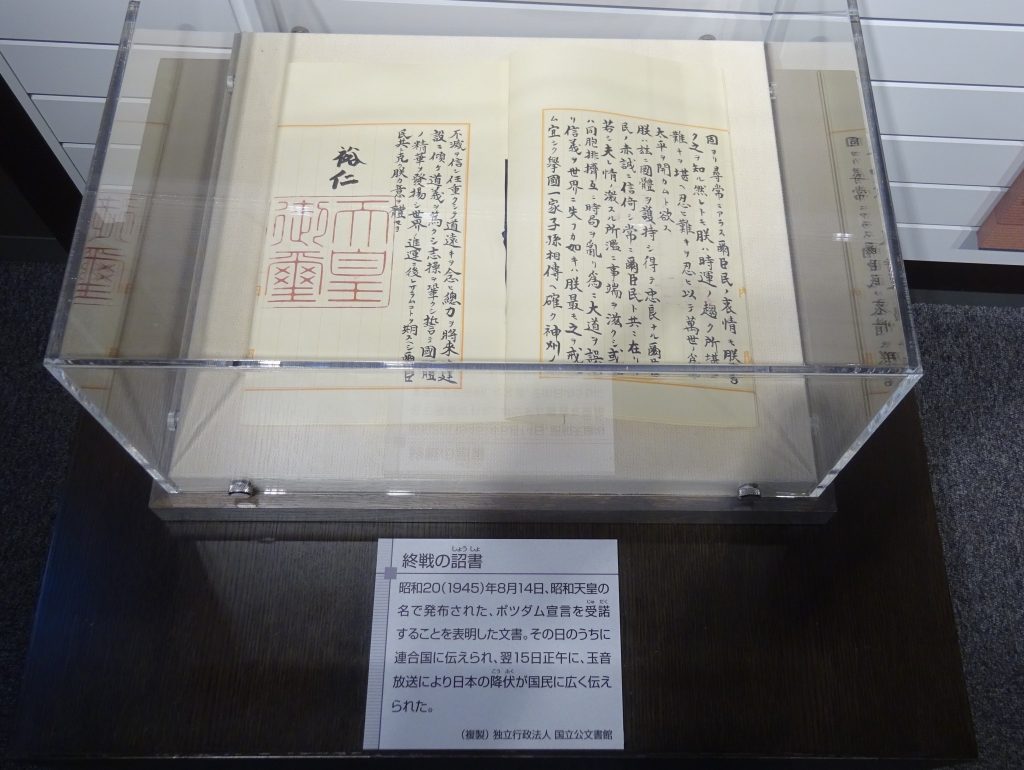
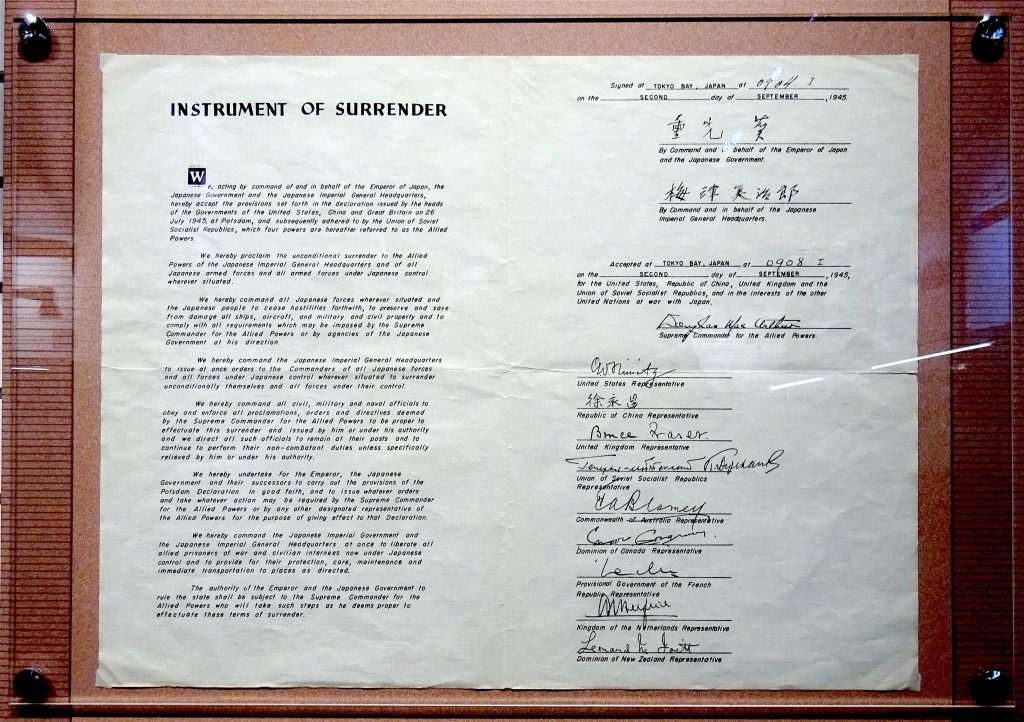

We hereby undertake for the Emperor…to carry out the provisions of the Potsdam Declaration…
The authority of the Emperor…shall be subject to the Supreme Commander…
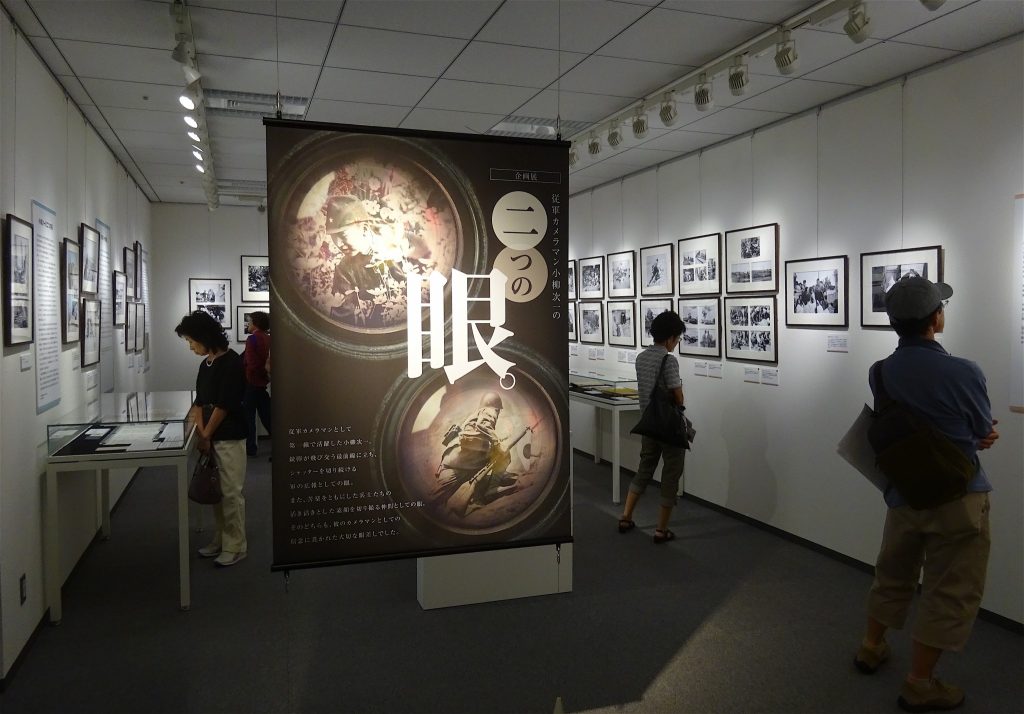
企画展 従軍カメラマン小柳次一の二つの眼
小柳次一(1907~1994)は、昭和13(1938)年から終戦までの長期にわたって、陸軍嘱託の従軍カメラマンとして活躍しました。今回の企画展では、写真だけではなく小柳という人物に焦点を当て、その人となりを取り上げます。従軍日記と関連する同時期の写真、愛用のカメラ、バルナック・ライカの同型機、画家の向井潤吉、兵隊小説で知られる作家の火野葦平らとの交友関係、戦後の戦没者遺族との交流などを紹介します。
そして、写真がいつ・どこで・何を・何のために・どうやって撮影されたのか、その歴史的意味に迫ります。
http://www.heiwakinen.jp/event_insite/20180510-2351.html
次の展覧会:
平成30年9月4日(火)~10月28日(日)
平和祈念交流展「シベリアの記憶 家族への情愛~香月泰男展」
平和祈念展示資料館では他館と連携した交流展を行っています。今年度は山口県長門市の香月泰男美術館と連携し、平和祈念交流展を開催します。
この交流展では、香月泰男美術館のご協力により、ほとんど館外へ出ることのなかった香月のシベリア抑留関連の作品と、家族の情愛を描いた作品を紹介し、あわせて香月が入隊以来手放すことのなかった絵具箱やハイラルから出した軍事郵便なども展示します。
28:10 min 海軍作戦記録 支那事変
山村睦夫 @ 和光大学、和光経済、2015年
戦前期上海における日本人居留民社会と排外主義 1916 ~ 1942(上) ―『支那在留邦人人名録』の分析を通じて―
Japanese Small Business in Shanghai and their Chauvinism 1916 ~ 1942 – An Analysis on “Derectory of Japanese Residents in China” –
http://id.nii.ac.jp/1073/00003780/
蘇智良著『上海の慰安所施設
― 「大一サロン」旧日本軍史上最初の慰安所の真相を暴く― 』
斎藤敏康 訳 、立命館経済学、2016
http://ritsumeikeizai.koj.jp/koj_pdfs/64616.pdf
http://www.wikiwand.com/ja/日本の慰安婦
中国における慰安婦陳列展示施設について (2016/10/25)
https://inmylifeao.exblog.jp/26573648/
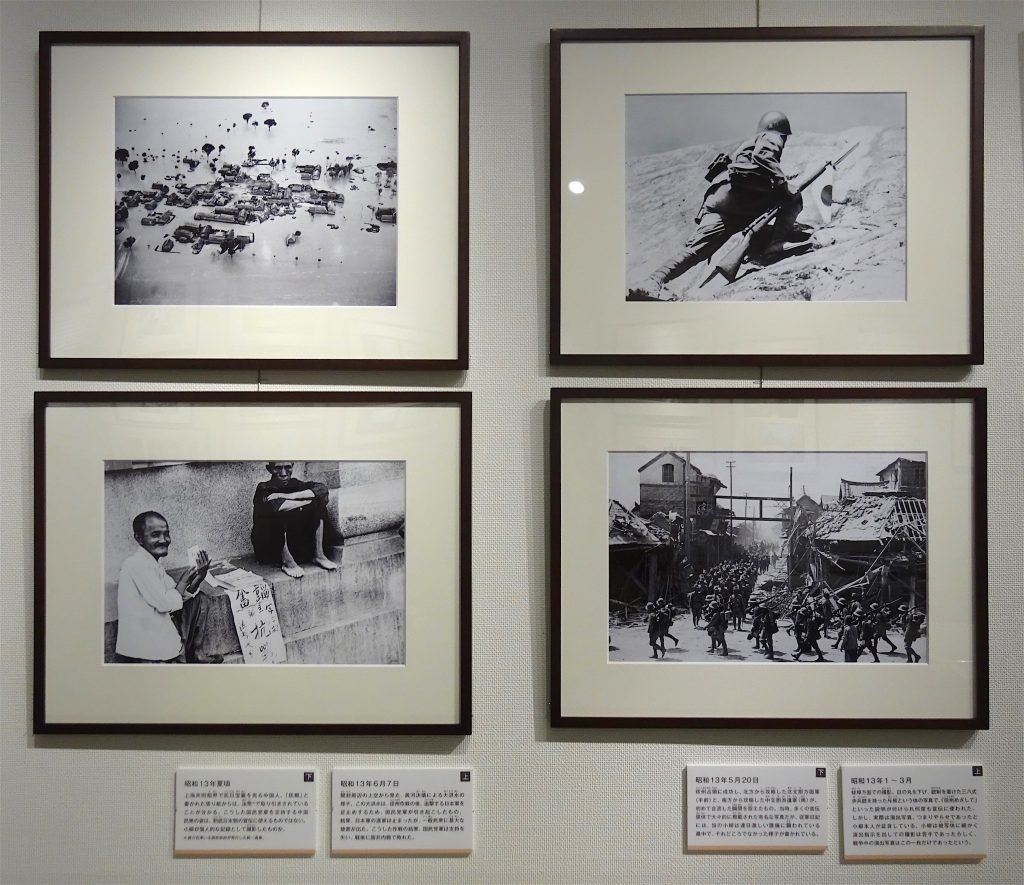
左下:昭和13年夏頃
上海共同租界で抗日宝籖を売る中国人。「抗戦」と書かれた張り紙からは、法幣で取り引きされていることが分かる。こうした国民党軍を支持する中国民衆の姿は、到底日本側の宣伝に使えるものではない。小柳が個人的な記録として撮影したものか。
皇紀2603 昭和18年 1943年
1:12 min
カイロ宣言の参加者 宋 美齢(青天白日勲章)
Mme. Chiang Kai Shek addresses the House of Representatives in Washington DC, U.S.A. (1943)
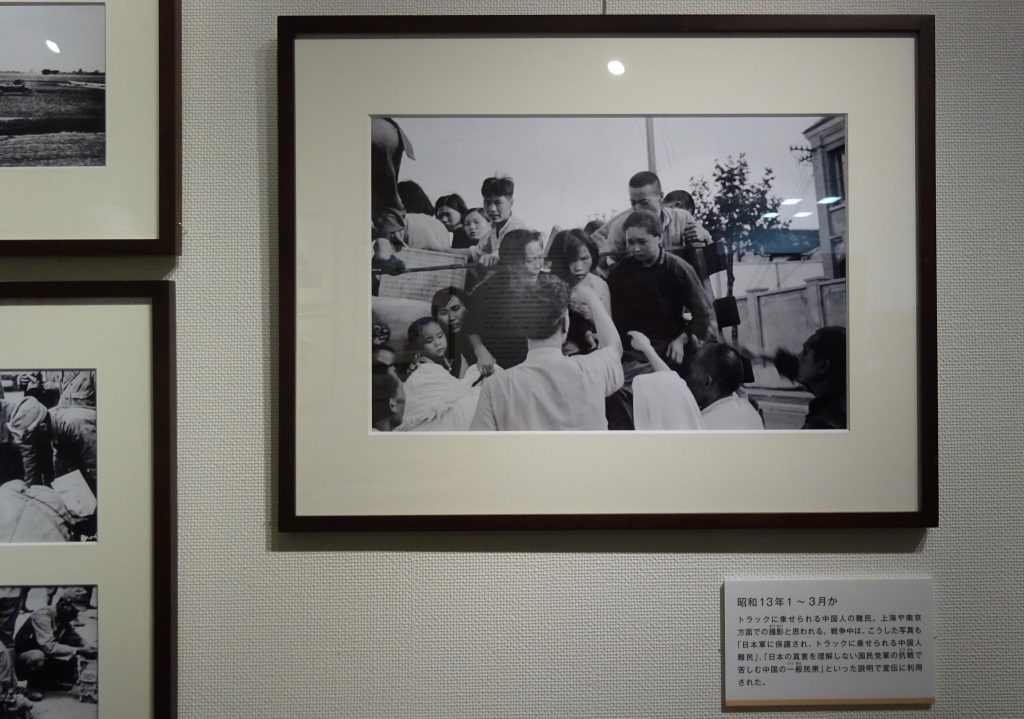
昭和13年1〜3月か
トラックに乗せらる中国人の難民。上海や南京方面での撮影と思われる。戦争中は、こうした写真も「日本軍に保護され、トラックに乗せられる中国人難民」、「日本の真意を理解しない国民党軍の抗戦で苦しむ中国の一般民衆」といった説明で宣伝に利用された。
皇紀2602 昭和17年 1942年
1:43 min
日本ニュース・日本ニュース・日独同盟・日独伊三国同盟二周年の式典
The Asahi Shimbun Displays
What is Europe?
Views from Asia
23 August – 22 October 2018
The British Museum, London
http://www.britishmuseum.org/whats_on/exhibitions/what_is_europe.aspx
Exploring the interconnected relationships between Asia and Europe from the 18th century to the mid-20th century, this exhibition looks at Europe from the outside.
Examining perceptions of Europe through a series of objects from Japan, China and South Asia, this display illustrates how encounters between Asia and Europe are often far more nuanced than has been previously presented. The exhibition includes a wide variety of objects that challenge common preconceptions – from prints, magazines and paintings to sculptures and protective figures.
Two objects from the Nicobar Islands in the Indian Ocean shed light on the complex artistic response to European trade and power relations. The Islands were colonised by Denmark in 1756, and then sold to Britain in 1869, and are now a union territory of India. A Nicobarese hentakoi (painted board) shows the selective adoption of European practices and goods, and the importance of local objects deemed valuable and symbolic. Hentakoi were thought to have protective powers, and this example shows a European ship, a local vessel and a Chinese boat, as well as a deity flanked by a compass and chronometer. A kareau (protective figure) from the Nicobar Islands is also included in the display – portrayed wearing a European pith helmet.
Subtle examples of subversion and dissent are also on display, such as the reception of European religions in Asia – a porcelain figure of the bodhisattva Guanyin and child shows this relationship. Made for hundreds of years for Buddhist devotion in China and Japan, in the 18th century some manufacturers added Christian imagery to these statues in the form of a mantilla – a Christian head-covering. Christianity was forbidden in Japan from 1587–1859, so sculptures like this, made for European export markets, allowed ‘hidden’ Christians to worship in secret in Japan.
The ridicule and mocking of Europe is also represented in the exhibition. A 1943 manga magazine mocks Allied wartime leader Winston Churchill, and an earlier print made during the Russo-Japanese war of 1904–1905 ridicules the Russian Navy, describing them as ‘aimless boats’.
The display contains examples of the multi-faceted relationship and mutual adoption of Asian and European artistic styles. Instances of Western influence on Asian artists are shown alongside Chinese porcelain made for export to markets in Europe. There are also links between individual artists in the exhibition – German printmaker Käthe Kollwitz and Chinese artist Li Hua.
Together, the objects in this display reveal the nuanced and complex relationships between Asian and European nations from the 1700s to the mid-1900s, presenting narratives from many different backgrounds and encouraging debate about the present.
used at artdaily:

Prince Arthur of Connaught offering the Order of the Garter to the Meiji Emperor . Japan 1906, British Museum
compare with:

Bijutsu Jiji Gaho No 6
Lithograph print. Prince Arthur of Connaught offering the Order of the Garter to the Emperor Meiji, on behalf of King Edward VII. Date: 1906
http://www.britishmuseum.org/research/collection_online/collection_object_details/collection_image_gallery.aspx?partid=1&assetid=607674001&objectid=784113
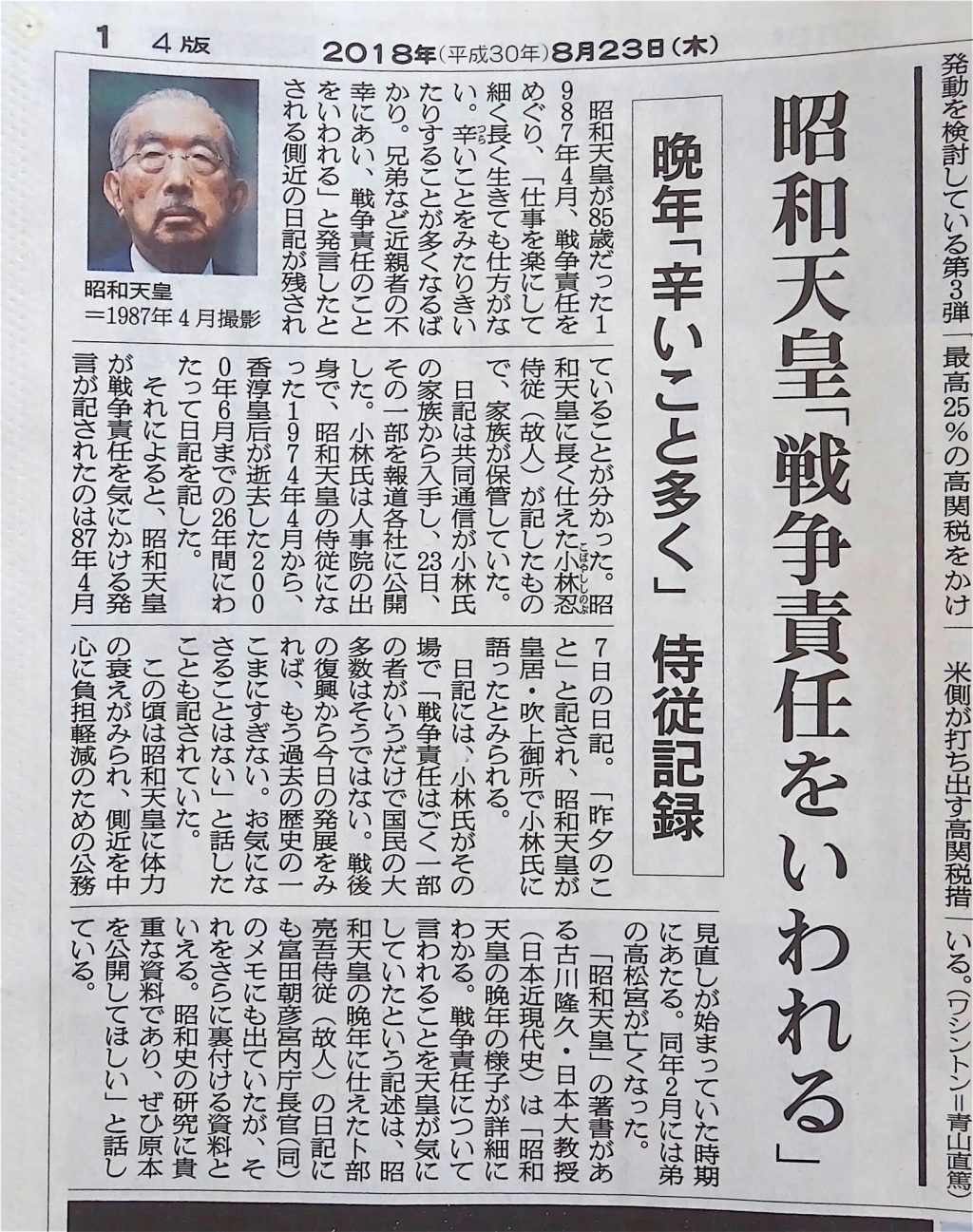
朝日新聞、夕刊
Hirohito pained by talk of war responsibility, diary shows
THE ASAHI SHIMBUN, August 23, 2018
quotes:
Shortly before his death in January 1989, Emperor Hirohito confided that he was much vexed by talk about his war responsibility.
Entries from a diary kept by his late chamberlain, Shinobu Kobayashi, illustrate the deep anguish Hirohito felt when people raised the issue.
He is known posthumously as Emperor Showa.
…
“There is no point in living a longer life by having my workload lessened,” the emperor said. “It would only increase my chances of seeing and hearing a trying thing. I have experienced the deaths of my close relatives, including siblings, and hear (people) talking about my war responsibility.”
…
According to the diary’s April 7 entry, the emperor was in residence at the Imperial Palace the previous evening when he lamented talk about his war responsibility.
The entry shows that Kobayashi tried to assuage his anguish.
“Only a handful people are talking about (your) war responsibility, not a large majority of the public,” the diary reads. “It is now only part of history, given how the country has developed today after the rebuilding in postwar years. You do not need to worry.”
Takahisa Furukawa, a professor of Japanese modern history at Nihon University, called the diary an “invaluable piece of material” for researchers of the Showa Era (1926-1989), given the detailed descriptions of Hirohito in his final years.
“The description that the emperor was concerned about the talk about his war responsibility also appears in the diary kept by late chamberlain Ryogo Urabe and a memo written by Tomohiko Tomita, a former Imperial Household Agency grand steward,” he noted. “(Kobayashi’s diary) provided additional material to support their writings.”
Furukawa called for the release of Kobayashi’s original diaries.
The full text, see:
http://www.asahi.com/ajw/articles/AJ201808230049.html
—
Read the biography written by The Imperial Household Agency:
Emperor Showa and Empress Kojun
http://www.kunaicho.go.jp/e-about/history/history11.html
——-
皇室
大嘗祭「公費支出避けるべきでは」秋篠宮さまが懸念
毎日新聞 2018年8月25日
来年5月に即位する新天皇が五穀豊穣(ほうじょう)を祈る皇室の行事「大嘗祭(だいじょうさい)」について、秋篠宮さまが「皇室祭祀(さいし)に公費を支出することは避けるべきではないか」との懸念を宮内庁幹部に伝えられていることが関係者への取材で判明した。大嘗祭は来年11月14日から15日にかけて皇居・東御苑での開催が想定されている。政府は来年度予算案に費用を盛り込む。
宗教色が強い大嘗祭に公費を支出することには、憲法で定める政教分離原則に反するとの指摘がある。政府は今年3月に決定した皇位継承の儀式に関する基本方針で、「宗教的性格を有することは否定できない」としながらも、「皇位が世襲であることに伴う重要儀式で公的性格がある」と位置付けた。費用は平成の代替わりの際と同様、皇室行事として公費である皇室の宮廷費から支出する。
平成の大嘗祭では、中心的な行事「大嘗宮(だいじょうきゅう)の儀」の祭場建設のための約14億円を含めて費用は総額約22億5000万円に上った。関係者によると、同程度の儀式を行った場合、物価の変動などを考慮すると、費用は大幅に増える可能性がある。
通常の皇室祭祀は、天皇、皇后両陛下と皇太子ご一家の私的生活費である内廷費で賄われる。これに対して、皇室の公的活動は宮廷費から支出される。政府は大嘗祭について宮廷費で予算措置を講じる方針だが、秋篠宮さまは宮内庁幹部に対して多額の宮廷費が使われることへの懸念を示したうえで「内廷費で挙行できる規模にできないだろうか」とも話しているという。今年度の内廷費は3億2400万円だった。
秋篠宮さまは、新天皇が即位すると、皇位継承順位第1位の皇嗣となる。同庁幹部は秋篠宮さまの懸念について、毎日新聞の取材に「承知していない」としている。
皇室祭祀などに詳しい宗教学者の島薗進・上智大学教授は「皇嗣となる方の素直な意見として歓迎したい。大嘗祭に公的な費用が使われることは、国の宗教的な活動を禁じる憲法20条に抵触する恐れがあり、本来好ましくない。政府は多様な意見を踏まえて、慎重に皇位継承儀式を進めてほしい」と話している。
http://mainichi.jp/articles/20180825/k00/00m/040/169000c
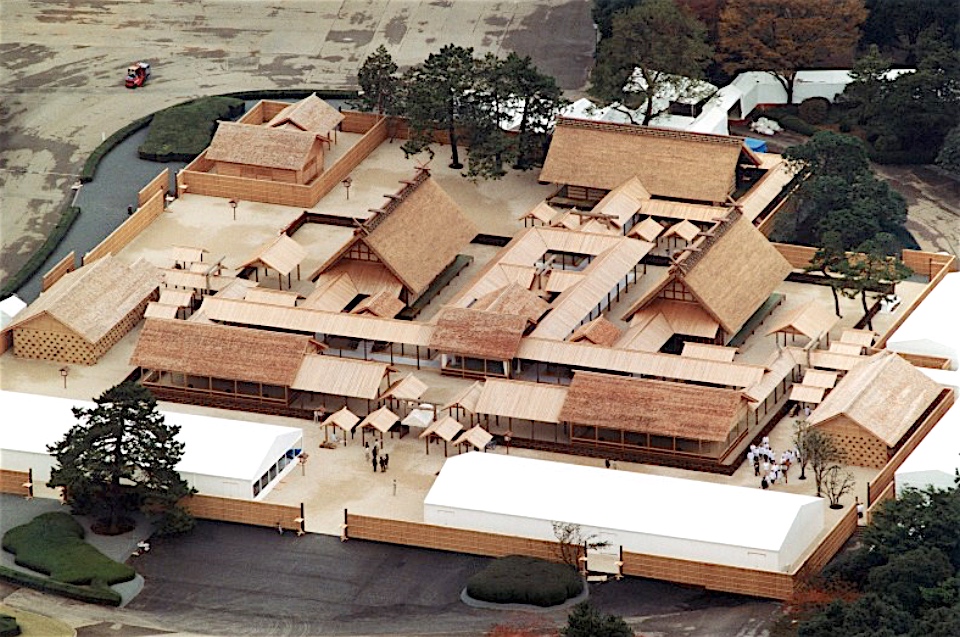
大嘗祭の準備が整った大嘗宮。右が悠紀殿、左が主基殿、奥が廻立殿。鳥居も立てられている=皇居・東御苑で1990年11月21日、本社ヘリから
A temporary hall for Daijosai, or the Grand Thanksgiving rite, in which the new emperor offers new rice to the gods for the first time with a prayer for an abundant harvest, is pictured here inside the East Gardens of the Imperial Palace in a file photo taken from a Mainichi Shimbun helicopter on Nov. 21, 1990. (Mainichi)
Prince Akishino questions use of public funds on religious Imperial enthronement rites
August 25, 2018 (Mainichi Japan)
TOKYO — Prince Akishino, the younger brother of Crown Prince Naruhito, voiced his concerns to a top Imperial Household Agency official that using public funds to cover Imperial rites should be avoided, a source close to the agency has told the Mainichi Shimbun.
Prince Akishino stated his concern in reference to the “Daijosai,” or Grand Thanksgiving rite, in which the new emperor will offer new rice to the gods for the first time with a prayer for an abundant harvest after he accedes to the throne next May. The rite is expected to take place from Nov. 14 to 15 next year inside the East Gardens of the Imperial Palace after Emperor Akihito abdicates on April 30 and Crown Prince Naruhito accedes to the Imperial Throne on May 1. The government will incorporate the cost of the ritual in its fiscal 2019 draft budget.
Critics have pointed out that spending public funds on the Daijosai, which is highly religious, violates the principle of separation of religion and government as guaranteed by the Constitution.
Within the basic guidelines that the government decided upon this past March regarding ceremonies related to Imperial succession, it said that “it could not be denied that the ceremonies have a religious nature” but also “are public in nature in that they are important rites associated with the hereditary succession of the throne.” As was the case when Emperor Akihito acceded to the throne, public funds allocated for public Imperial ceremonies will be spent on events relating to Crown Prince Naruhito’s rise to the throne.
The Daijosai at the start of the Heisei era cost some 2.25 billion yen total, including the approximately 1.4-billion-yen spent on building a venue for the Daijokyu-no-gi, a central event within the Daijosai. According to those involved in the upcoming ceremonies, if similar rituals are carried out next year, the cost could possibly be much higher, taking into consideration inflation and other factors.
Ordinary Imperial rites are covered by funds allocated for the private living expenses of the Emperor and Empress, and the Crown Prince and his family. Public Imperial activities, meanwhile, are covered by public Imperial funds. The government plans to allocate a budget for the Daijosai from public Imperial funds, but Prince Akishino has expressed his concern about this plan.
In addition to making clear that he was worried about having massive amounts of public Imperial funds spent to cover the ceremony, he has asked whether it is possible to pare down the ceremony itself, so that the private living funds of the Imperial Family could be used to pay for the ceremony. The Imperial Family was allocated private living funds of 324 million yen for fiscal 2018.
Prince Akishino will be first in line to the throne once his brother, Crown Prince Naruhito, becomes emperor. A senior official from the Imperial Household Agency told the Mainichi Shimbun that they are not aware of Prince Akishino’s concerns regarding the Daijosai.
“I’d like to welcome (Prince Akishino’s concern) as an honest opinion of someone who will be the first in the line of succession,” said Susumu Shimazono, a religious scholar and a professor at Sophia University who is well-versed in Imperial rites. “The use of public money for the Daijosai runs the risk of violating Article 20 of the Constitution, which states that ‘the State and its organs shall refrain from religious education or any other religious activity,’ and is ill-advised. I hope the government considers a diverse range of views and moves forward with ceremonies relating to Imperial succession with discretion.”
http://mainichi.jp/english/articles/20180825/p2a/00m/0na/019000c
—————————
皇室
退位儀式 憲法整合性に配慮
毎日新聞 2018年2月21日
政府が20日に概要を決定した天皇陛下の退位の儀式は、国民主権と象徴天皇制を定める憲法との整合性に配慮した。過去の例では不可欠だった、天皇が皇位を譲る意思を示す「宣命(せんみょう)」の扱いが論点の一つだったが、首相が退位特例法に基づいて陛下が退位されると表明する案で落ち着いた。
「陛下お言葉」首相の後
政府は20日の式典準備会合で、有識者4人から個別に非公開で意見聴取した結果を報告した。「国民主権原則に沿い、象徴にふさわしい在り方が求められる」(園部逸夫・元最高裁判事)、「伝統的な儀式を参考にしながら、戦後憲法に適合した在り方が必要」(所功・京都産業大名誉教授)など、全員が憲法の趣旨に沿いつつ伝統を尊重するよう求めた。
政府が示した退位の儀式についての「考え方案」では、国民の代表としての首相が、国会が制定した特例法の…
つづき:
http://mainichi.jp/articles/20180221/ddm/002/040/121000c
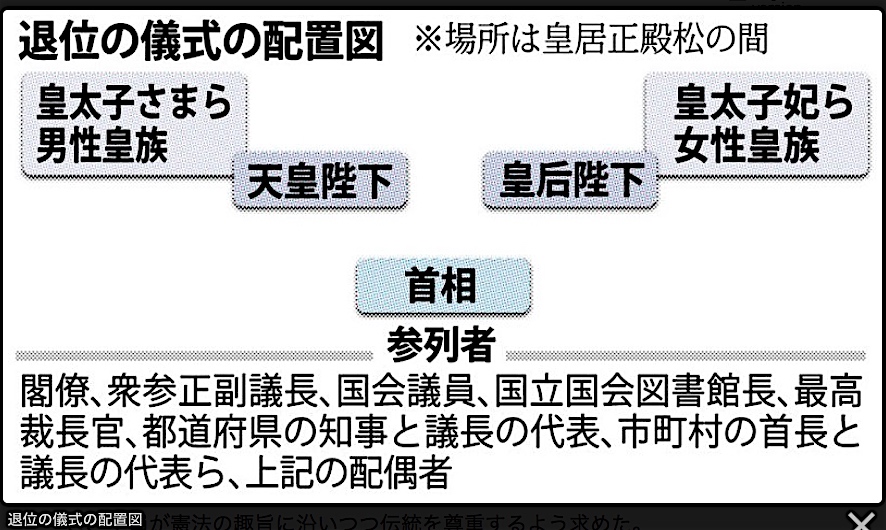
Gov’t outlines ceremony for Emperor’s abdication to fit in with Constitution
February 21, 2018 (Mainichi Japan)
The government has outlined a plan for the abdication ceremony for Emperor Akihito conforming to the Constitution, which stipulates that sovereignty resides with the people and that the Emperor is the symbol of the state and the unity of the people.
One key point of contention was how to handle the issue of an imperial edict in which the Emperor would declare his intention to hand over the Imperial Throne. Such edicts were indispensable during abdication ceremonies of emperors in the past.
The government has basically decided that the prime minister will announce that the Emperor will retire in accordance with a special measures law on the Emperor’s abdication.
The government reported the outcome of its hearings of opinions from four experts during a preparatory meeting for the abdication ceremony on Feb. 20.
All of the experts urged that the ceremony be held in accordance with the Constitution’s spirit while respecting the traditions of the Imperial Household.
“In line with the principle of sovereignty residing with the people, the ceremony should be suited to the Emperor being the symbol of Japan,” former Supreme Court Justice Itsuo Sonobe was quoted as saying during a hearing.
“The ceremony needs to be held in such a way that it conforms to the postwar Constitution while taking into consideration ceremonial traditions,” Isao Tokoro, professor emeritus at Kyoto Sangyo University, was quoted as saying during a hearing.
In its plan for the abdication ceremony, the government proposed that the prime minister declare Emperor Akihito’s abdication in accordance with the special measures law enacted by the Diet, on behalf of the people, and express gratitude to the Emperor. This is to clarify that the Emperor is stepping down under the law — not just by his own will.
Emperor Akihito will read a statement on his retirement after the prime minister’s declaration.
During the hearings, Sonobe, Tokoro and Keiko Hongo, professor at the University of Tokyo’s Historiographical Institute, insisted that the Emperor read a statement on his abdication during the ceremony.
However, concerns remain that depending on the content of the Emperor’s statement, it could constitute his involvement in national politics, which is banned by the Constitution. If Emperor Akihito mentions his abdication, it could give the public the impression that the Emperor is stepping down on his own will.
To avoid that, the government characterized the Emperor’s statement as one addressing the public. The Cabinet and the Imperial Household Agency are expected to adjust the content of the Emperor’s statement to conform to the Constitution.
Some conservatives claim that the Emperor’s abdication ceremony and the Crown Prince’s enthronement ceremony should be held at the same location on the same day so that the retiring Emperor can hand over a sacred sword and jewel to the new emperor as Imperial Regalia.
While the Constitution stipulates that the Emperor’s position derives from the will of the people, who have sovereign power, conservatives have placed emphasis on the Emperor’s position as the inheritor of the Imperial Regalia. However, a majority of the experts have voiced opposition to these opinions of conservatives.
Hongo told a hearing that since the aim of the abdication and enthronement ceremonies is to widely inform the public, there would be no problem if there were an interval between these two events.
Sonobe was quoted as telling a hearing that it would be inappropriate to hold a ceremony in which His Majesty hands over the Imperial Regalia while he is still on the Imperial Throne.
While showing consideration for the traditions of the Imperial Household, the government intends to clearly separate the abdication and enthronement ceremonies to avoid giving the public the impression that the Imperial Throne is being handed over through the ceremonies, from the viewpoint of conforming to constitutional provisions.
The government has decided that a chamberlain will bring the sacred sword and jewels into the room where the abdication ceremony will be held and leave the room with these items following the ceremony.
This is in line with the opinion expressed by former Deputy Chief Cabinet Secretary Nobuo Ishihara to the effect that it would be appropriate if these traditional items that have been handed over along with the Imperial Throne are placed near His Majesty at the time of imperial succession.
http://mainichi.jp/english/articles/20180221/p2a/00m/0na/010000c
大岩オスカール「光の満ちる銀座」
Oscar Oiwa A Light-filled Ginza
東京画廊+BTAP
Tokyo Gallery+BTAP | Tokyo
2018/7/21 – 9/22
Open 11 – 19, Saturday: 11-17, closed Sun + Mo
104-0061 東京都中央区銀座8-10-5 第4秀和ビル7階
7F, 8-10-5 Ginza, Chuo-ku, Tokyo 104-0061 Japan
http://www.tokyo-gallery.com/exhibitions/intokyo/post-420.html
http://www.tokyo-gallery.com/en/exhibitions/intokyo/post-420.html
ウェブサイトより:
もう遠い昔のことになりましたが、画廊は銀座にあると言われ、情報誌「ぴあ」を手に握って初めてこの銀座エ リアの画廊まわりをしました。僕がまだ大学生の時のことで、初めて日本に来て一気に 100 ヵ所以上の画廊を回 り、なんとなく自分なりに日本のアートシーンを頭の中に描きました。二十歳になったばかりの僕には、この銀 座の世界はとても華やかに見えました。ブラジルのサンパウロで育ったので、海外の情報が少なく、全てが冒険 でした。インターネットも携帯電話もない時代だったので、行った先で何が起こるか分からず、その時その時で 行動を決めていかなければなりませんでした。
あれから世の中は国際的になり、あの時代が懐かしいです。自分はいつの間にか銀座を回る若者ではなく、銀座 の画廊で展示をする側になりました。僕は数日前、韓国から戻って来たところで、時差で朝早く起き、ニューヨ ークで朝5時にこの原稿を書いています。窓の外はまだ薄暗く、遠くに見えるタイムズスクエアの光を眺めなが ら、考えます。あれから 30 年も経ち、日本は美術館や作品を展示する場所が増え 、アートの環境は良くなって きたのではないかと思います。奨学金やアーティスト・イン・レジデンス、海外留学の機会が増えたおかげで、 今の若い世代は銀座エリアの画廊まわりをする人は、少なくなって、貸画廊は減ってきているのではないかと思 います。
銀座で展覧会をするのは久しぶりです。今回の個展では、僕が今まで見てきた「頭の中の風景の光」を展示しよ うと思いました。僕は見た物に対してはわりと良い記憶を持っていて、頭の中に多くの情報が入っています。 見ることとはその「風景の光」を見ていることではないかと思います。その時の自分の精神状態と場所、時間に よって、ごく普通の日常的な風景でも特別に見えてくることがあります。その一瞬の「頭の中の光」を固定して、 それを絵にまとめていきました。夕焼けの光、森からくる光 、水の反射。このような人知れず過ぎていく一瞬 の出来事を形にして生まれた作品を展示しようと思いました。
2018年3月
大岩オスカール
http://www.tokyo-gallery.com/img/2018OO_PR_JP.pdf
A long time ago when I was young, I was told that the galleries were in Ginza, and so I got a copy of the magazine Pia, and went around to the galleries in Ginza for the first time. I was still a university student back then, visiting Japan for the first time, and went to over 100 galleries, getting an idea of what the Japanese art scene was like from this experience. I had just turned 20, and the world in Ginza seemed like a glamorous place. I grew up in São Paulo, in Brazil, with very little information about what it was like overseas, and so everything seemed like an adventure. It was before we had the Internet and cell phones, so you never knew what would happen when you got there, and had to decide a lot on the spot.
The world has become a lot more international since then, and I get nostalgic for that generation. Before I knew it, I went from being a young man gallery hopping in Ginza, to one who shows in a gallery there. I am writing this at 5 am in New York, since jet lag woke me up after just having come back from South Korea a few days ago. It is still dark out, and I’m lost in thought as I look out the window at the light of Times Square in the distance. Thirty years have passed, and there are more and more places, like museums, to exhibit work in Japan, and overall it seems to me that the environment for art is getting better. There are more scholarships, artist residencies, and study abroad opportunities, and I imagine that young people probably spend less time walking around the galleries in Ginza, and rental galleries must be disappearing as well.
It’s been a while since I’ve had a show in Ginza. For this solo show, I wanted to exhibit the “light of the scenes in my mind” that I had been seeing until now. I have a fairly good photographic memory, and thanks to that, have a lot of information stored in my head. I would say that to see something is to see the “light of that scene.” Depending on one’s emotional state, the location, and the time, an ordinary scene might look extraordinary to the person seeing it. I capture that momentary “light” in my head in the painting. The light of the sunset, the light coming from the forest, the light reflecting off the water. The work captures the shapes of these unnoticed momentary incidents.
March 2018
Oscar Oiwa
http://www.tokyo-gallery.com/img/2018OO_PR_EN.pdf
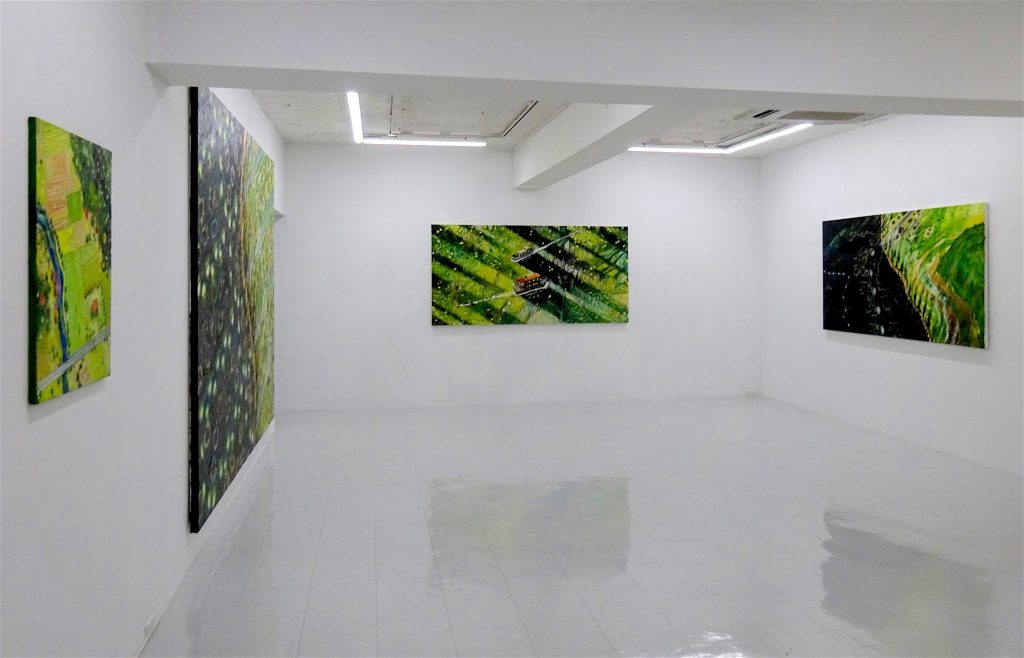
大岩オスカール「光の満ちる銀座」OIWA Oscar “A Light-filled Ginza”、展示風景 exhibition view @ Tokyo Gallery+BTAP | Tokyo

大岩オスカール OIWA Oscar “Moon Reflex” 2018
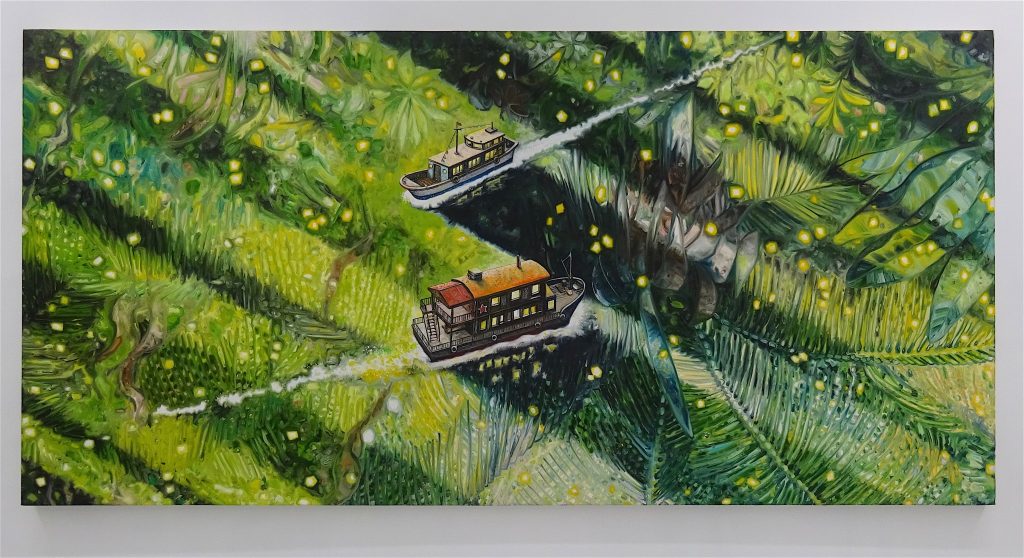
大岩オスカール OIWA Oscar “Chalana 3” 2015
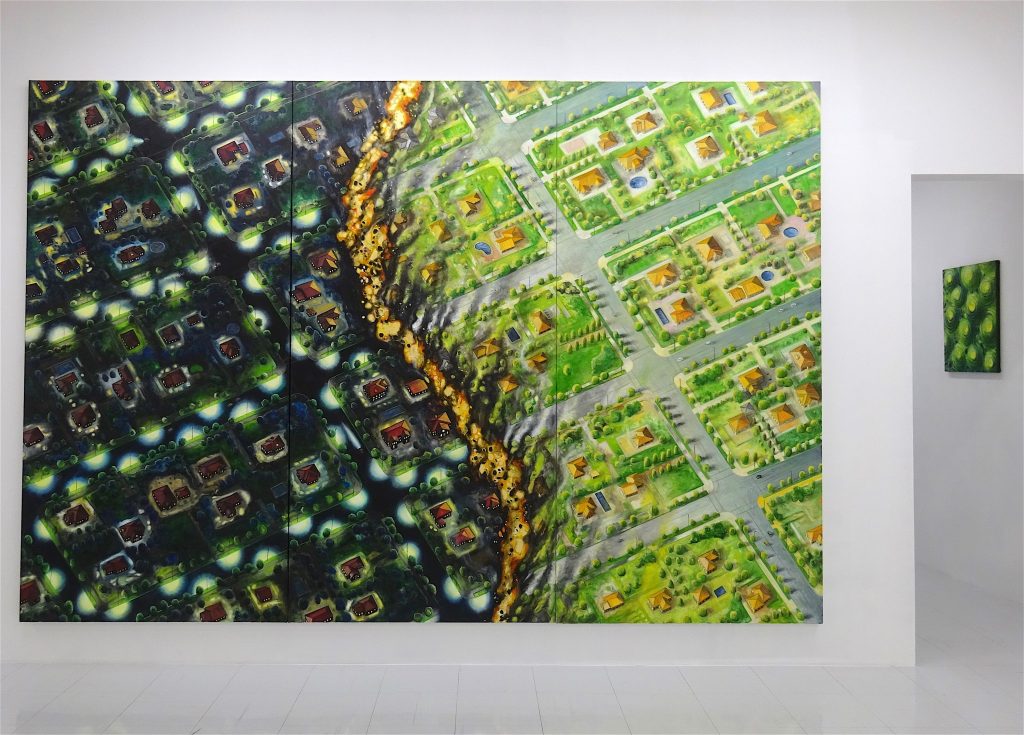
大岩オスカール OIWA Oscar “Twilight” 2017, right side: “Mountain, Road” 2018

移動中、典型的な銀座の風景 Moving from one gallery to the other in actual Ginza
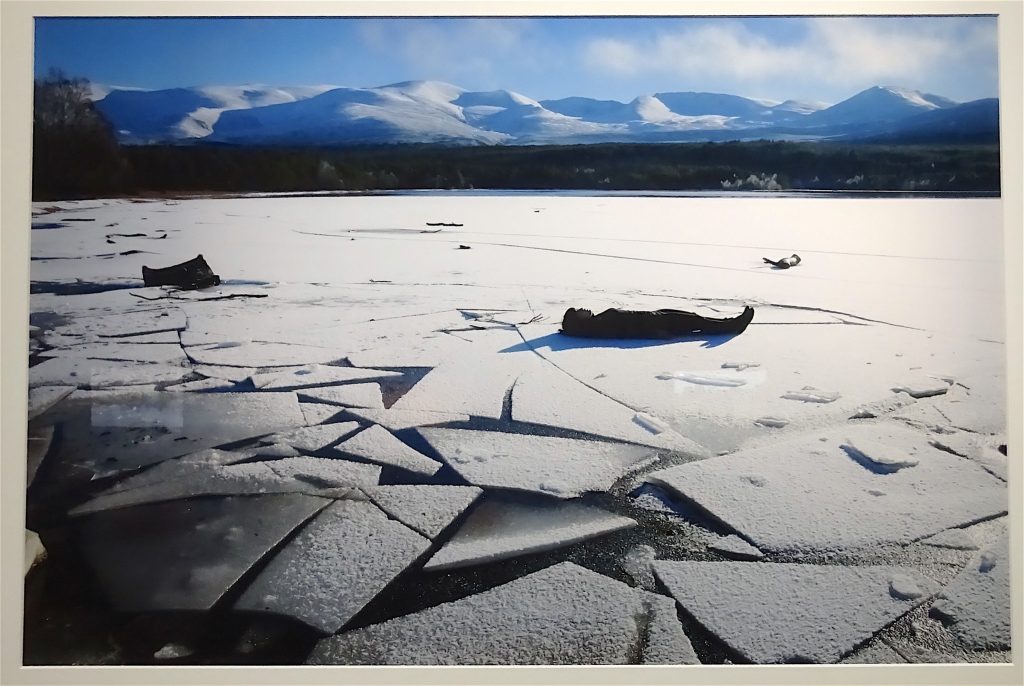
宇多村英恵 UTAMURA Hanae “Aviemore” 2011, C-print
第12回 shiseido art egg 宇多村英恵 展 Hanae Utamura Exhibition
Holiday at War 戦争と休日
資生堂ギャラリー Shiseido Gallery
2018/8/3 – 26
東京都中央区銀座8-8-3 東京銀座資生堂ビル地下1階
Tokyo Ginza Shiseido Building, basement floor
8-8-3 Ginza Chuo-ku, Tokyo, 104-0061
https://www.shiseidogroup.com/gallery/exhibition/past/past2018_03.html#anchor3
https://www.shiseidogroup.com/gallery/exhibition/past/scene2018_03.html
“shiseido art egg 12” Exhibition Announcement
For nearly a century since its 1919 opening, the Shiseido Gallery has been promoting Shiseido’s corporate ideal of “discovering and creating new value.” In 2006, the Gallery began the”shiseido art egg,” a public exhibition program designed to support promising new artists. Each year the selected artists are offered opportunities to show their work at the Shiseido Gallery. As with any Shiseido Gallery showing, these exhibitions are planned and executed in collaboration with a professional curator and various specialists of the Shiseido Gallery staff.
This year’s 12th shiseido art egg collected applications from 350 potential participants from all around Japan, roughly 70% of whom are in their twenties or thirties. Among the many who proposed very creative plans to take advantage of the Shiseido Gallery’s distinctive exhibition space, artists Yuma Tomiyasu, Koichi Sato, and Hanae Utamura were eventually selected for their rich artistic sensibilities and unique perspectives. These three will present their works at the Shiseido Gallery in succession during the period from June 8 (Friday) to August 26 (Sunday). We invite one and all to visit the Shiseido Gallery to discover what these next-generation artists are bringing to the table.
“shiseido art egg 12” Selection Committee
伊藤俊治 ITO Toshiharu: Professor of Tokyo University of the Arts and Shiseido Gallery Advisor
光田由里 MITSUDA Yuri: Art Critic and Shiseido Gallery Advisor
資生堂ギャラリー学芸スタッフ Shiseido Corporate Culture Department
After all three solo exhibitions have finished, a three-member judging panel will select one of the exhibiting artists to receive the “shiseido art egg prize.” This year’s panel will include artist Manika Nagare, photographer Naoya Hatakeyama, and publisher Yoshiyuki Morioka.
The winner will be announced in mid-September 2018 on the Shiseido Gallery website, and there will be an award ceremony open to members of the public interested in the activities of these new artists.
shiseido art egg 賞発表、2018年9月中旬 ウェブサイトにて発表
https://www.shiseidogroup.jp/gallery/artegg/about/index.html
PR text:
宇多村英恵は、国や人種、異なる社会的立場を超え、個人と他者が対峙できる空間を生み出すことを目指し、映像やパフォーマンス、インスタレーションの作品を制作してきました。展覧会では、特に身体性に重きをおいたインスタレーションを行います。パフォーマンスの経験を展示のなかでどのように展開していくかという課題のもと、展覧会を鑑賞する観客がパフォーマーとして参加することを通して、展示作品としてのパフォーマンスの可能性を模索します。
Hanae Utamura work goes beyond nationality, race, and social class, using video, live performance, and installation to create spaces where individuals may come face to face with each other. For this exhibition, she will present an installation with a heavy emphasis on physicality. By considering how the experience of the performance will unfold within the exhibition, Utamura makes the audience itself a participant in the performance, thereby exploring the possibilities of performance as an exhibited work.

宇多村英恵 UTAMURA Hanae “Holiday at War” 2016, mixed media
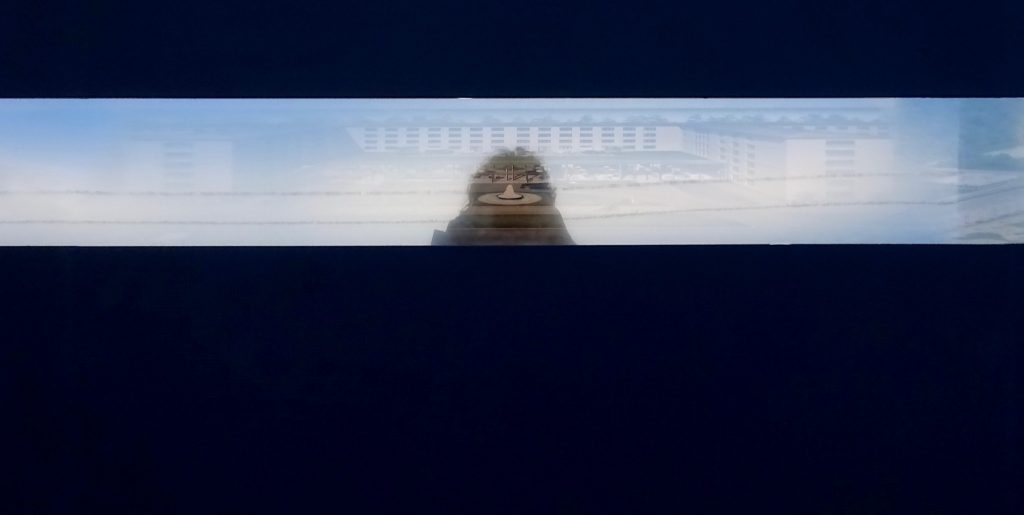
“Holiday at War” detail

“Holiday at War” detail

宇多村英恵 UTAMURA Hanae “Splashing Water in the Sahara Desert (Tunisia)” 2010, video
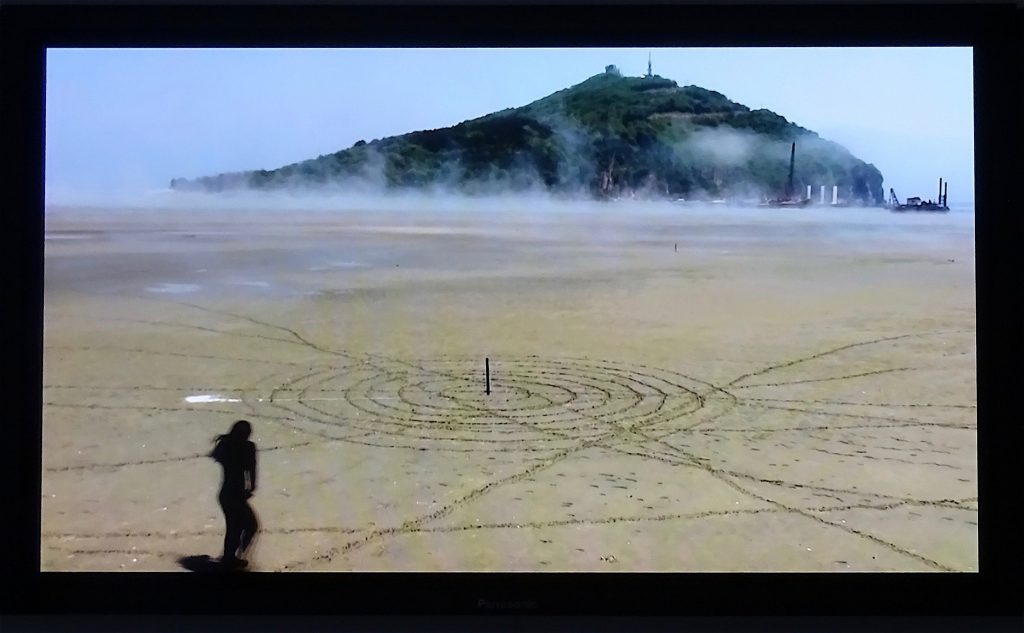
宇多村英恵 UTAMURA Hanae “When a line becomes a circle” 2013, video

宇多村英恵 UTAMURA Hanae “Leisure in Time”, Series “Residue:Skin“, 2015, mixed media
